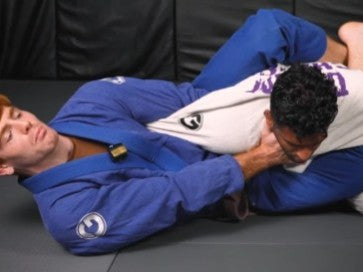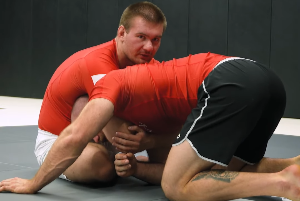Want to dive into the numbers of BJJ? You're in the right spot. We've done the research, including our own proprietary surveys to bring some interesting Jiu Jitsu statistics to the mats.
High Level Jiu Jitsu Stats
Let's kick things off with a high level overview of the sport of Jiu Jitsu and it's growing popularity.
How many people practice Jiu Jitsu?
Our research shows the best estimates are:
- Approximately 6 million people practice Jiu Jitsu worldwide
- Approximately 750,000 people practice Jiu Jitsu in the USA
While it's hard to pin down an exact figure here, we can definitely see a clear trend in the explosive growth of Jiu Jitsu:

In the past 10 years, interest in BJJ across the United States has doubled. This trend has generally been "up and to the right" aside from a short blip in early 2020 (for obvious reasons).
How many Jiu Jitsu Black Belts are there?
Let's talk about the elite of the elite – BJJ black belts. There are 8,783 BJJ black belts registered with the International Brazilian Jiu Jitsu Federation.

Over 2,000 have gone the extra mile to verify their belt status on BeltChecker.com. So, the real number? It's anyone's guess! It has to be well over 10,000 though.
If you had to pin me down for an exact figure, I'd estimate there are 40,000 Jiu Jitsu black belts worldwide. That sounds about right to me; approximately one in four are registered with the IBJJF.
Statistics from our "State of Jiu Jitsu" Survey
In late 2024/early 2025, we ran a state of Jiu Jitsu survey that yielded nearly 2,000 responses from BJJ practitioners along with some incredibly interesting insights.
In this section we'll cover a few that I found interesting. If you'd like to run your own analysis, we also share the raw data here. If you use it, please credit us and link back to this page. Seriously, we put a lot of money into this survey. If you don't, I will find you and I will wristlock you.
How long does it take to get each Jiu Jitsu belt?
There are some common sayings you hear like "it'll take 18 months to get a blue belt" or "a black belt takes 10 years to earn." Our data shows that the true figures are a bit longer!
Here are the average times it takes to achieve each belt rank in Jiu Jitsu:
| Belt | Average Years to Earn Belt | Average Years Spent at Belt |
|
White |
2.3 | |
|
Blue |
2.3 | 3.3 |
|
Purple |
5.6 | 3.4 |
|
Brown |
9.0 | 4.4 |
|
Black |
13.3 |
Across the board, the amount of time it takes to earn each belt is more than you might expect!
This is not due to any outlier data, we filtered out extreme numbers and the "median" results are nearly exactly the same as the averages. Earning belts in Jiu Jitsu is just pretty dang hard 😆
How much does Jiu Jitsu cost?
One very opaque area of the sport is how much academy dues cost on average. We surveyed nearly 2,000 Jiu Jitsu practitioners and
| Region | Average Monthly Jiu Jitsu Dues |
| United States | $146.15 |
| Europe | $100.83 |
| Asia | $154.29 |
| Brazil | $150.00 |
Coming from San Diego, those numbers surprised me a bit. I'd say your average gym dues here are closer to $200. I was curious to run the numbers by state, so here's what they look like for the states we got the most respondents from:
| State | Average Monthly Jiu Jitsu Dues |
| California | $155.79 |
| Texas | $153.06 |
| Florida | $156.67 |
| New York | $173.19 |
| Pennsylvania | $131.28 |
So you can see there is quite a bit of variance by state! New York was by far the most expensive state (followed by nearby New Jersey) while Oklahoma, Maine, Michigan, and Kansas tended to have the cheapest monthly dues.
What are the most popular Jiu Jitsu submissions?
Another stat we were curious about was what are the most popular submissions in Jiu Jitsu. Here are the most popular "favorite submissions" broken down by belt level:

A couple of takeaways...
- The triangle is incredibly popular at white belt, but wanes in popularity quickly.
- White and blue belts love the Americana, while upper belts do not. Not too surprising!
- Upper belts love the armbar, while it's less popular at white and blue belt. Makes sense as it takes a lot of practice to control someone effectively to the level you can execute an armbar.
- The Ezekiel choke is pretty steady in popularity at all levels. This is one submission where I would have expected it to peak at white belt and drop off fast.
- While white and blue belts like ankle locks and heel hooks, only brown and black belts favored kneebars. Similar to the armbar, this is a submission where setting it up and controlling someone is difficult so it makes sense that higher belts are more bullish on it (vs falling back on a sloppy ankle lock).
- Arm triangles are popular! I was surprised to see this submission in the top 3 across all belt levels.
How common are Gym Uniform Policies?
One polarizing topic in Jiu Jitsu right now is requiring all students to wear an academy uniform. Some people love it, others view it as a money grab.
Out of 1,920 respondents in the United State, 502 (26%) said their gym had a uniform policy. 14% of respondents said they love uniform policies, 35% said they hate them, and the rest didn't have a strong opinion.
Something to think about if you run a gym!
How popular is competing in Jiu Jitsu?
"Should you have to compete" is another hot question in the Jiu Jitsu community.
| Have you competed? | |
| No | 756 (38.8%) |
| Yes (not in the past 2 years) | 343 (17.6%) |
| Yes (in the past 2 years) | 849 (43.6%) |
Competition experience is way more prevalant than I would have expected! I was shocked to see that nearly half of respondents had competed in the past 2 years
I thought it was interesting that out of the 160 black belts that completed the survey, only 8 had never competed. Whereas at white belt, 520 out of 784 respondents (66%) had zero competition experience.
So my take is that yes, at least getting a taste for competition is an important part of the journey to black belt.
Jiu Jitsu Technique Stats
Now let's dive into some stats on the actual technique side of Jiu Jitsu.
What is the most popular Jiu Jitsu guard to play?
This one surprised me! Half guard is actually more popular than closed guard:

I was also shocked to see K Guard (which was so popular at CJI) and collar sleeve guard (a gi staple, in my opinion) coming in so low in the rankings. 33 people love rubber guard and only 2 play collar sleeve!? C'mon now guys 🤣
Broken down by belt, the stats do change a bit. Closed guard was by far the most popular guard for white belts. While half guard was significantly more commonly chosen at upper ranks.
We'll continue to add some more stats from our survey in the section above. For now, here are some more Jiu Jitsu statistics we compiled that you might find interesting...
How often do Jiu Jitsu matches end in a submission?
About a third of BJJ matches end in a submission. The rest? They go the distance, and it's up to the points or the ref to decide who's the winner.
How often do Jiu Jitsu matches start with a guard pull?
Guard pulls are 8 times more common than takedowns in BJJ. That's way more lopsided than I would have expected!
Jiu Jitsu in the UFC Stats
In the high-stakes world of the MMA, BJJ techniques have proven to be quite effective.
What is the Most Effective Jiu Jitsu Submission in MMA?
One particular move stands out: the rear-naked choke. It's the most successful BJJ submission in the UFC, responsible for nearly half of all choke finishes. To be precise, it accounts for 539 out of 1086 choke finishes, which is about 49.63%.
Is the Guillotine an Effective Submission in MMA?
Not far behind is the guillotine choke, another BJJ staple. This submission, in its various forms, is responsible for 21% of choke finishes in the UFC. It's a testament to the guillotine's versatility and the skill of the fighters who execute it.
How often is an MMA fighter choked unconscious?
Interestingly, 11.6% of BJJ choke submissions in the UFC result in the loser losing consciousness. This statistic highlights the seriousness and effectiveness of choke submissions when properly applied.
Is the Anaconda Choke an Effective Submission in MMA?
Among these, the Anaconda choke stands out for its efficiency. Approximately 35% of Anaconda choke submissions in the UFC end with the loser losing consciousness. This high rate of "Loss Of Consciousness" underscores the potency of this particular choke technique in the realm of professional MMA.
BJJ's impact in the UFC is undeniable, with these statistics painting a clear picture of its effectiveness, particularly in the realm of submissions.
What are the least common BJJ submissions in MMA?
My favorite "rare" submission in MMA is Frank Mir finishing Tank Abbott via toehold back at UFC 41.
When it comes to submissions that are popular in Jiu Jitsu, but haven't proven to be very effective in MMA I'd have to say the omoplata is probably at the top of the list. There have only been 2 successful omoplata finishes in the UFC. That's less than twisters (3), ezekiel chokes (4), or neck cranks (22).
Jiu Jitsu Safety Stats
How safe is BJJ? Is it a dangerous sport? Let's see what the statistics say.
First, we'll start with stats from our State of Jiu Jitsu survey. Of 1,948 respondents, 1,347 (69.1%) said they had not sustained a serious injury on the Jiu Jitsu mats.
At first glance, that stat looks pretty good! When you dig deeper though, you see to some extent it's just a matter of time...
While white and blue belts generally have not had a serious injury, by purple belt it's even money. And by brown or black belt you are a big favorite to have some sort of injury that pulls you away from the mats.

Unfortunately that's just the way it goes!
BJJ Injury Statistics in Competition
BJJ competitions obviously carry a risk of injury, primarily orthopedic in nature. One study revealed that out of 5,022 matches, there were 46 injuries with the most common being:
- Elbow injuries: 14
- Knee and rib fractures: 7 each
- Foot and ankle injuries: 5
- Hand and shoulder injuries: 4 each
- Lacerations requiring medical care: 3
- Hip and cervical injuries: 1 each
It's interesting to note that heel hooks were not allowed in these competitions, yet athletes still sustained plenty of knee and leg injuries.
BJJ Injury Statistics in Regular Training
Training injuries in BJJ are also a point of interest, as practitioners spend more time in gyms than in competitions. Several studies highlight different findings:
- A 2019 study indicated the knees, shoulders, and ribcage as top injury areas.
- A 2018 study among 180 novice and advanced BJJ athletes found shoulder and knee injuries most common.
- A 2017 study pointed to hands, fingers, feet, toes, and arms, elbows as common injury locations, with skin infections, knee injuries, and foot, toe injuries being medically diagnosed most frequently.
The 2019 study found that 59.2% of athletes had suffered at least one injury in the previous 6 months. Unsurprisingly, athletes with more training years and higher weight had fewer injuries, while those attending more classes per week and instructors had an increased risk.
Training vs. Competition: What's Riskier?
The 2018 study revealed that injury rates were slightly higher in training than in competition for novices, but the reverse was true for advanced athletes with higher belt ranks.
- Novice athletes: 54.5% in training vs. 45.5% in competition.
- Advanced athletes: 33.9% in training vs. 66.1% in competition.
Common Injury-Causing Techniques
One study based on over 2,500 competition matches in Hawaii found most orthopedic injuries were caused by the arm bar, followed by takedowns.
BJJ Injuries Compared to Other Martial Arts
A 2014 study from Hawaiian BJJ competitions showed BJJ has fewer injuries compared to judo, MMA, taekwondo, and wrestling. BJJ had the lowest injury rate per 1,000 athlete exposures.
Well, that's all we've got for now! We'll definitely run another "state of Jiu Jitsu" survey in the future. What BJJ statistics would you like to see us uncover?



